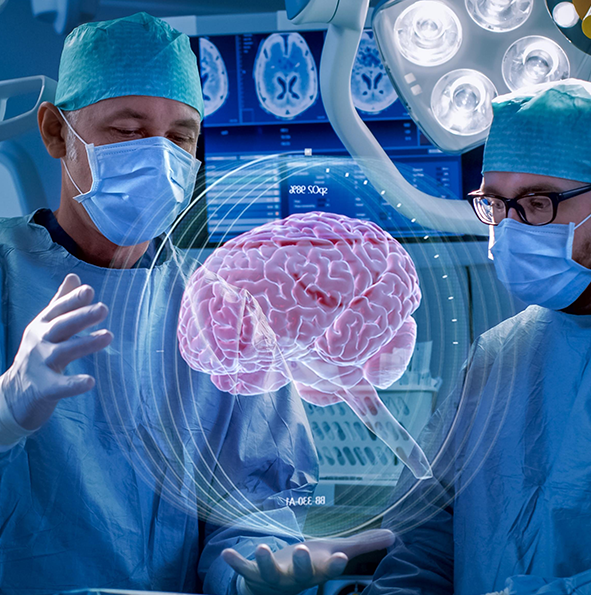What Is Keyhole Brain Surgery?
The concept of "keyhole" involves observing an entire room through the small opening in a door. Although it may be simpler to remove the door and potentially widen the opening by altering the frame, such methods require extra effort and the condition of the door after replacing might not be as good as before. A more refined approach involves achieving the same goals by examining the room through the keyhole from various angles of visualization. Keyhole brain surgery is also known as ‘minimally invasive brain tumor surgery’ , it may sometimes be performed as ‘neuro endoscopic surgery’. The objective of the surgery is to carefully remove brain and skull-based tumors with minimal disruption to the healthy brain tissue, blood vessels, and nerves surrounding the tumor.
This surgical approach involves the use of specialized instruments and techniques to access and remove the tumor through smaller and more precise incisions or natural body openings like the mouth or nostrils to remove the tumor.
Is Keyhole Brain Surgery the Option for You?
While keyhole brain surgery or minimally invasive brain tumor surgery has many advantages, it may not be required for all sizes and types of brain tumors. If the tumor is complex or large, it might necessarily require open surgery for optimal resection and access.
A keyhole brain surgery is suggested based on the patient’s unique circumstances, features of the tumor, and the surgeon’s judgment.
Keyhole surgery can also be an effective treatment for many conditions, such as:
-
Acoustic neuromas(C-p angle tumors) : This is an uncommon and non-cancerous tumor. It progresses slowly due to an excess of Schwann cells. The hearing and balance nerves in the inner ear are affected by the tumor. Keyhole surgery can help remove this tumor.
-
Meningiomas : These are tumors that arise in the meninges, the outer three layers of tissue that lie between the brain and the skull.
-
Gliomas : These are primary cancers of the brain. Based on histology they may be astrocytonas, glioblastomas,oligodendrigliomas etc.
-
Metastatic Brain or Spine Tumors: These tumors are brought on by cancer cells that have moved from other regions of the body to the brain.
-
Pituitary adenomas: They arise from the master gland of the body, and they may be effectively removed by scarless transnasal endocsopic surgery.
-
Intraventricular tumors : They are challenging tumors at the center of the brain and are surrounded by vital brain structures and the water-ways of the brain.
What Is The Process Of Keyhole Brain Surgery?
-
To properly plan the procedure, the surgeon will perform an MRI or CT scan before the surgery.
-
During keyhole surgery, a tiny incision around 2-6cm in diameter is made within the hairline of the head- it is usually hidden within the hair once it grows back. A 2-4 cm part of the skoll is opened to get access to the brain.
-
Through this opening, the surgeon can visualize the entire tumor or pathology. This is done via microscopes, endoscopes or exoscopes depending on the pathology.
-
The entire tumor can be removed by this small opening making for a clean surgery with short operating times.
(To enable the surgeon to make the necessary corrections, real-time video imaging makes it easier to see what's going on in the affected area. It helps the neurosurgeon avoid damage to tissues nearby)
Benefits of Keyhole Brain Surgery
Keyhole brain surgery provides significant potential advantages compared to standard open surgery. Because open surgery requires larger incisions, it also prolongs hospital stays and recovery time, and affects other factors. While a keyhole surgery can prove to be advantageous on these fronts.
Some benefits of keyhole brain surgery include:
-
Less pain than open surgery
-
Faster recovery than open surgery
-
Less scarring
-
Lesser complications and disfigurement
-
Less damage to surrounding tissues
-
Less risk of infection
It takes time to learn the ergonomics of doing surgery without damaging surrounding tissues and positioning equipment around the incision is key in the keyhole brain surgery. At WIINS, our goal is to minimize the possibility of problems, provide optimal outcomes, and shorten the duration of recovery.
Why Choose WIINS?
There are multiple risks linked to brain tumor removal surgery including bleeding and infection. Depending on the location and size of the tumor, there may be additional risks. Such risks include loss of vision if a tumor is surgically removed close to the nerves that supply your eyes.
At WIINS, we are equipped with an efficient Trauma Care Unit to treat brain diseases caused by traumatic brain injuries, stroke, and brain tumors.
Our cutting-edge technology and exceptional patient care have helped us successfully operate hundreds of patients and help them on their journey to speedy recovery.
At WIINS, we aim to ensure the safest possible surgical outcomes with the help of advanced technologies including CUSA, MRI tractography, Intraoperative Neuro Monitoring, and Neuro Navigation.
